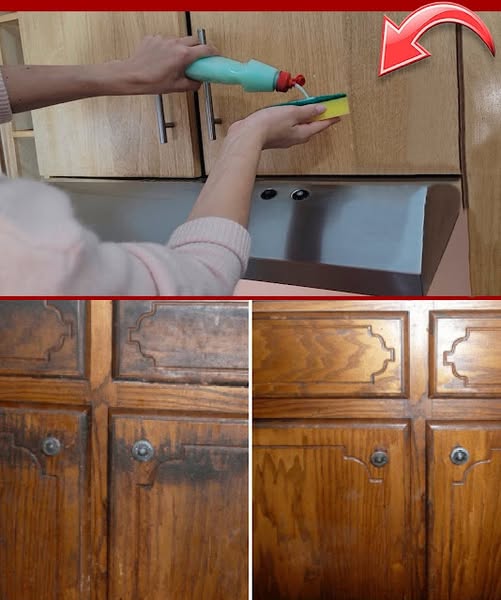Step-by-Step: How to Clean Greasy Kitchen Cabinets
Step 1: Mix the Cleaning Solution
In a bowl or bucket, combine:
- 1 cup of warm water
- 2 tablespoons of baking soda
- 1 tablespoon of dish soap (preferably degreasing)
Stir well until the baking soda dissolves completely and the mixture becomes slightly bubbly.
Step 2: Apply the Solution
- Dip a microfiber cloth or sponge into the mixture and wring out excess liquid.
- Gently scrub the greasy areas in circular motions, focusing on spots near the stove and sink where grease tends to accumulate.
💡 Pro Tip: For stubborn grease stains, let the solution sit on the surface for 5–10 minutes before wiping it off.
Step 3: Wipe Down
- Use a clean, damp cloth to wipe away the solution and remove any remaining grease.
- This step ensures no soapy residue is left behind.
Step 4: Dry & Shine
- Use a soft towel to dry the cabinets immediately—this prevents water spots and streaks.
- For extra shine, mix a few drops of olive oil with lemon juice, then gently buff your cabinets with a cloth for a smooth, glossy finish.
Why This DIY Cleaner Works So Well
✔ Baking Soda – A natural, non-toxic abrasive that lifts grease and deodorizes surfaces.
✔ Dish Soap – Breaks down stubborn grease and oil without damaging your cabinets.
✔ Warm Water – Helps dissolve sticky residue and softens tough buildup.
This method is gentle yet powerful, making it safe for wood, laminate, and painted cabinets.
Extra Tips for Keeping Kitchen Cabinets Grease-Free
💡 Clean Weekly: A quick wipe-down once a week prevents grease from building up.
💡 Use Cabinet Liners: Adding liners inside cabinets absorbs grease and spills, making cleaning easier.
💡 Ventilation Matters: Always use the range hood fan while cooking to reduce airborne grease.
💡 Avoid Harsh Scrubbing: If your cabinets have a glossy finish, use microfiber cloths instead of abrasive sponges to prevent scratches.
FAQs About Cleaning Kitchen Cabinets
1. Can I use vinegar instead of baking soda?
Yes! Vinegar is another great natural degreaser. Mix equal parts white vinegar and warm water, then wipe down greasy areas. However, avoid using vinegar on wood cabinets as it can strip the finish.
2. What if my cabinets are really greasy?
For extra-tough grease stains, make a paste using baking soda and water. Apply it to the grease, let it sit for 10–15 minutes, then wipe clean.
3. Is this method safe for all cabinet types?
Yes! This gentle cleaning solution works on wood, laminate, painted, and even metal cabinets.
4. How often should I clean my kitchen cabinets?
For best results, do a quick wipe-down once a week and a deep clean once a month.
Final Thoughts
Cleaning greasy kitchen cabinets doesn’t have to be a chore! With just a few household ingredients, you can remove grease buildup quickly and easily—no harsh chemicals, no scrubbing battles!
This simple DIY method keeps your kitchen looking fresh, clean, and grease-free with minimal effort.
📌 Don’t forget to save this cleaning hack for later and share it with friends!
